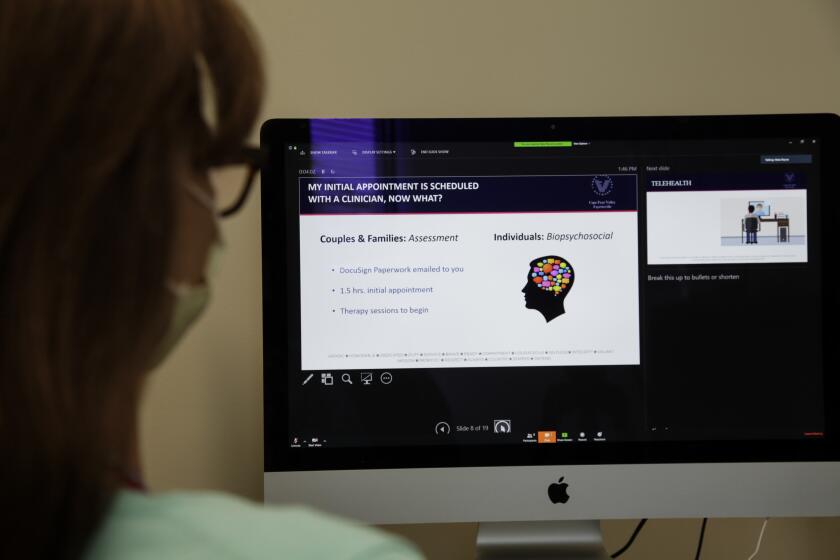Opinion: Troubled youth? Contrary to stereotypes, much of Gen Z is doing just fine

- Share via
Recent surveys underscoring the prevalence of mental health challenges among young people leave me very concerned — not just about the findings but also about counterproductive perceptions of younger generations.
A Common Sense Media poll found that 53% of the country’s 12- to 17-year-olds see mental health challenges as a major problem in their schools. And a Gallup-Walton Family Foundation study reported a significant decline in the proportion of Gen Z youths who consider their mental health excellent since 2013. These findings echo a Centers for Disease Control and Prevention survey indicating 42% of high school students had experienced such persistent feelings of sadness or hopelessness in the past year that they couldn’t participate in regular activities, up from 28% in 2011.
I’ve already heard adults labeling today’s young people the Hopeless Generation, the Anxious Generation, the Depressed Generation, the COVID Generation and the Troubled Generation. The latest surveys threaten to reinforce such stereotypes.
The rules initially blocked me from seeing an out-of-state therapist through telehealth. But depression is depression, whether you live in Texas or California, Alaska or Hawaii.
Don’t get me wrong: Given my years of work on youth mental health, I understand that it’s imperative to address this challenge. But while we’re doing that, we can’t forget that many young people aren’t struggling.
While only 20% of those surveyed by Gallup-Walton reported that their mental health was “excellent,” for example, 44% said it was “good,” along with 26% reporting “only fair” and 10% “poor.” We need to address these mental health challenges without labeling an entire generation as troubled.
I have spent the last nine years listening to what adolescents think and feel in focus groups, two nationally representative studies of 9- through 19-year-olds, in-depth interviews with young people from these studies and a school behavioral study. One of the questions I asked is what they want the adults of America to know about people their age.
Thirty-eight percent answered “don’t stereotype us” or “don’t label us,” an overwhelming number for an open-ended question. They emphasized that not all young people share the same challenges.
We need to avoid thinking children will recover from the past year without mental health support. Young people are resilient, but they are vulnerable.
In their words: “Not all of us fall under the umbrella of being problematic drug addicts”; “All kids aren’t troublemakers or irresponsible”; and “We aren’t social-media-obsessed, we aren’t extremely self-involved, our phones don’t define us, and the internet is not going to be the end of us.”
These responses show that we adults have to try harder to hold two ideas in our minds as we parent, teach and raise the next generation. We need to address the real challenges that some young people face without subjecting all of them to unhelpful generalizations.
Yes, adults have long been too ready to attach negative labels to teenagers. This has been true since the dawn of the study of adolescent development in the early 20th century. It was regarded as a time of “storm and stress” then as it is today.
In one of my studies, we asked the parents of 9- through 19-year-olds to describe the typical adolescent brain in one word. Fifty-nine percent used negative words, while 27% used neutral words and only 14% used positive words. But when I asked parents to select from a list of positive and negative words to describe children their child’s age as well as to describe their own child, they were much more likely to be negative about other people’s children than their own.
We also found that parents who used negative words to describe the teen brain were more likely to have children who reported more negative feelings, including anger, sadness, loneliness and worry.
What comes first, young people’s negative feelings or parents’ negative views? We couldn’t fully answer that question, but we could control for factors that might affect how adults see teenagers, such as demographics, the level of conflict between parents and children, and the negative words parents use to describe their children. Our finding of a correlation between views and feelings held up.
The relationship also persisted when we surveyed the same parents and adolescents again nine months later, during the pandemic. To put it another way, the parents who held more positive views of teenagers in general had kids who were doing better during a very rough period in our nation’s history.
Parents in my studies told me again and again that kids live up or down to the views we have of them. Seeing this generation as a troubled or anxious generation could therefore lead adults to act in ways that exacerbate the mental health challenges that some but not all adolescents face.
So what can we do? We as a society certainly need a mental health system that provides access to affordable, high-quality, consistent care more reliably that it does now. We need the education provided by our schools to be more engaging, relevant and meaningful. And we need to mitigate the risks of social media to young people.
Beyond these monumental undertakings, however, all of us can help in smaller, everyday ways. We can work to improve young people’s relationships with the people in their lives, especially the older people — a point that the surgeon general’s 2021 report on youth mental health emphasizes. Our own study found that when adolescents reported that that they were treated with respect, made to feel as if they belong, and helped to grow and learn, they fared well during the pandemic. They got better grades, had a more hopeful view of their futures and were less stressed.
It’s similarly important that we refrain from the age-old pastime of deriding and dismissing teenagers. Let’s remember that while adolescence can be a time of great vulnerability, it can also be one of huge possibility.
Ellen Galinsky is the president of the Families and Work Institute and author of the forthcoming “The Breakthrough Years: A New Scientific Framework for Raising Thriving Teens.”
More to Read
A cure for the common opinion
Get thought-provoking perspectives with our weekly newsletter.
You may occasionally receive promotional content from the Los Angeles Times.












